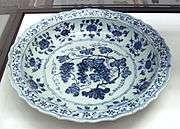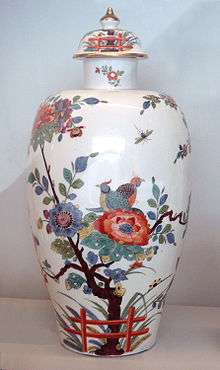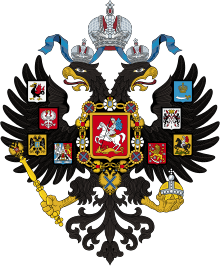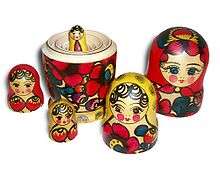Imperial Porcelain Factory
 Logo of Imperial Porcelain | |
Native name | Императорский Фарфоровый Завод |
|---|---|
| Industry | Hand-painted Ceramics Manufacturing |
| Founded | Saint Petersburg, Russia (1744) |
| Founder | Dmitry Ivanovich Vinogradov |
| Headquarters | Saint Petersburg, Russia |
Area served | International |
| Owner | Nikolai Tsvetkov |
| Website |
www |
The Imperial Porcelain Factory (or Manufactory) (Russian: Императорский Фарфоровый Завод, Imperatorskii Farforovyi Zavod), is a producer of handpainted ceramics in Saint Petersburg, Russia. It was established by Dmitry Ivanovich Vinogradov in 1744. and was supported by the Romanov tsars since Empress Elizabeth. Many still refer to the factory by its well-known former name, Lomonosov Porcelain Factory.
Imperial Years
Founded in 1744, the first porcelain manufactory in Russia was created by order of Empress Elizabeth, daughter of Peter the Great, to "serve native trade and native art."[1] The factory produced wares exclusively for the ruling Romanov family and the Russian Imperial court.
Attempts to reveal the secret of hard paste true porcelain-making had expanded to Russia since the visit of Peter the Great to Saxony in 1718; there, he saw Meissen porcelain at the Dresden court. A talented mining engineer Dmitry Ivanovich Vinogradov, who studied metallurgy at Freiberg, Saxony, invented the formula for the Russian porcelain works established in 1744.
1744-1762 The Vinogradov Period
The Russian porcelain by Vinogradov had qualities similar to the Saxon porcelain, while its formula which consisted of only Russian ingredients, took its style from Chinese porcelain. At the beginning of the Vinogradov period the motifs were monochrome and simplified; by the end of this period the fine miniatures were completed on porcelain. Gold leaf for gilding porcelain was prepared from golden coins from the Imperial Treasury.
1762-1801. Catherine's Porcelain. Porcelain of Paul I's Reign. Early Classicism
‘The Golden Age of Catherine’ – the reign of Catherine II the Great – was the age of prosperity for the fine Russian porcelain. In 1765 the manufactory was renamed the Imperial Porcelain Manufactory (IPM). From the very beginning of Catherine's reign IPM was obliged to produce fine porcelain and also to bring profit. The Imperial Court's need for porcelain was large, and the permanent orders from the Court let IPM maintain the highest quality.
During the reign of Paul I (1796 to 1801) the Russian porcelain continued to develop in style of Neoclassicism with the increasing influence of Hellenic and Roman motifs.
IPM Porcelain in the 19th Century. 1801-1825. Porcelain of Alexander's Reign. Restructuring of IPM. High Classicism, Empire Style
Masters from Berlin Königlische Porzellan Manufaktur and porcelain painters from the Manufacture nationale de Sèvres were invited to St Petersburg. The kiln chamber was restructured. Then in 1806, with the imposition of Napoleon's Continental Blockade, the import of porcelain to Russia was banned and competition between a variety of Russian private porcelain factories arose. The production line of IPM porcelain was divided into a department for producing expensive low-profit Royal presents and a department producing ordinary porcelain for consumers among the Russian nobility.
1825-1894. Historical period. Reigns of Nicholas I (r.1825-1855), Alexander II (r.1855-1881), Alexander III (r.1881-1894)
From the reign of Nicholas I (r1825 to 1855) imported kaolin from Limoges began to be used. Porcelain plaques and large porcelain items of high perfection were made. A special method of durable fire gilding that could be burnished was invented, although subsequently lost.
Nicholas I took a personal part in the managing of IPM. The projects for porcelain items were handed in to him for his confirmation. The manufactory's own museum was established in 1844. Later on a library was formed from books on art, paintings and engravings.
By the beginning of the reign of Alexander II (1855 to 1881) IPM worked only with imported raw materials. A year before the abolition of serfdom the IPM workers had been given their freedom, but many of them continued to work at IPM. However, the number of the Imperial Court's orders decreased. The porcelain was produced mainly on old models. From the beginning of the 1870s copying of famous paintings on porcelain ceased, and landscapes were rarely painted. Instead, purely ornamental decoration prevailed. IPM started to use coloured glazes and to decorate their porcelain with pâte-sur-pâte patterns.
The idea of closing down the ‘useless and unprofitable’ enterprise emerged in 1881. Later on the idea transformed into the assignation of IPM to the Imperial Academy of Arts but Alexander III, whose reign had just started, commanded the best possible conditions from technological and arts point of view to IPM so that IPM could bear its name "Imperial" with dignity and set a standard for all private porcelain manufactory owners.
In 1889 the new formula was invented for the dark red sang-de-boeuf glaze. Since 1892 the underglaze decoration technology had been mastered with the help of Danish experts. The Russian Emperor was married to a Danish princess and paid interest to the underglaze painting.
1894-1917. The Russian Art Nouveau. Reign of Nicholas II
By the beginning of the 20th century the IPM had become one of the leading porcelain factories in Europe. IPM porcelain was famous for its exceptional quality. It was produced from paste made of the highest quality ingredients on up-to-date equipment. This paste was stored in cellars for 10 years before use in production.
The Art Nouveau style influenced the shapes of the porcelain. Porcelain was produced with whimsically curved forms decorated by stylized plants, mermaids and other Art Nouveau motifs. As a rule, the vases were covered by underglaze decor. Every vase had a unique form. The underglaze decoration made it possible for the artists to paint changeable seasons and winter landscapes.
The IPM began to produce technical and chemical porcelain due to the end of imports of porcelain from Germany during World War I. The production of fine porcelain was decreased to a minimal level. All the fine porcelain items produced were sold at charity auctions benefitting the Royal hospitals. Only Easter eggs were produced in large quantities for Easter celebrations of soldiers.
After the October Revolution of 1917 IPM was nationalized and renamed to State Porcelain Factory (GFZ).[2] (The Cooper–Hewitt, National Design Museum collection has 51 objects from the State Porcelain Factory.)[3]
After the Revolution

With the abolition of the Russian monarchy in 1917, the Imperial Porcelain Factory was renamed "State Porcelain Factory" (GFZ - Gossudarstvennyi Farforovyi Zavod) by the Bolshevik regime.[1] During the early years of the Soviet Union, the GFZ produced so-called propaganda wares, ranging from plates to figurines of the Soviet elite.[4]
In 1925, on the occasion of the 200th jubilee of the Russian Academy of Science, it was given the name of the academy's founder, Mikhail Lomonosov. It became known as the Leningrad Lomonosov Porcelain Factory (LFZ - Leningradski Farforovyi Zavod imeni M.V. Lomonosova).[5] The newly christened Lomonosov factory produced a range of wares, including collectible animal figurines and dinner sets.
Its best-known pattern, cobalt net, first appeared in 1949. The design is based on a blue net pattern that was painted on raised lines cast into the porcelain dinnerware pieces of Catherine the Great. The factory has actual examples of Catherine's dinnerware with this design. The new design pattern is a combination of intersecting lines of cobalt blue with inverted tear drops of cobalt blue (made from mineral cobalt) and 22 karat gold accents.[6]
After the Soviet Era
LFZ was privatized in 1993 as the "Lomonosov Porcelain Factory". At that time, wide exports began to countries unfamiliar with Lomonosov wares, particularly the United States and Japan. KKR and The U.S. Russia Investment Fund owned 51% until 1999, when the Russian government nationalized the company.[7] In 2002, LFZ was sold to Nikolai Tsvetkov, President of Nikoil.
Return to Old Name
On 29 May 2005, the stockholders of Lomonosov Porcelain Factory passed a resolution to return to their pre-Soviet name, the Imperial Porcelain Manufactory.[8]
The IPM has recently started to produce hand-made copies of porcelain from the range of Imperial porcelain exhibited in the State Hermitage Museum collection. This range includes dinner sets, collectable plates, vases, figurines from the famous series of the Russian Peoples and other porcelain items from the assortment of porcelain made here since the foundation of the manufactory in 1744.
Post-Soviet Backstamps


The first post-Soviet export backstamp was a red LFZ monogram, with "Made in Russia" stamped in red. After 2002, a new export backstamp appeared which featured a red or a blue LFZ monogram along with the words "Hand Decorated, 1744, St. Petersburg, Russia." The post-2005 pieces are stamped "Imperial Porcelain, 1744, St. Petersburg," along with the double-headed imperial eagle.
See also
Notes
- 1 2 The Lomonosov Porcelain Story, , accessed 18 June 2007
- ↑ Imperial Porcelain: The History of Russian Imperial Porcelain from 1744 to 1917:
- ↑ Smithsonian Cooper-Hewitt, National Design Museum. "State Porcelain Factory". Smithsonian Institution. Retrieved 18 December 2012.
- ↑ After the October Revolution, , accessed 18 June 2007
- ↑ Porcelain of the Czars, , accessed 18 June 2007
- ↑ About Lomonosov Porcelain, , accessed 18 June 2007
- ↑ Banerjee, Neela (October 16, 1999). "INTERNATIONAL BUSINESS; Frustrated, Russian Securities Regulator Resigns". The New York Times. Retrieved October 27, 2016.
Mr. Vasiliev's decision to leave was clinched by a St. Petersburg court's decision on Monday to renationalize the Lomonosov porcelain factory, a move that annulled a 51 percent stake held in the company by executives of Kohlberg Kravis Roberts & Company and the U.S.-Russia Investment Fund.
- ↑ "Press Releases" archive, Official Lomonosov Porcelain Factory website, , accessed 18 June 2007 (in Russian)
External links
- Official Imperial Porcelain Manufactory Website: Imperial Porcelain Manufactory (in English)
- Making of Russian Imperial (Lomonosov) Porcelain (video)
- Imperial Porcelain Factory collection at the Cooper-Hewitt, National Design Museum
Coordinates: 59°52′49″N 30°26′30″E / 59.88028°N 30.44167°E






